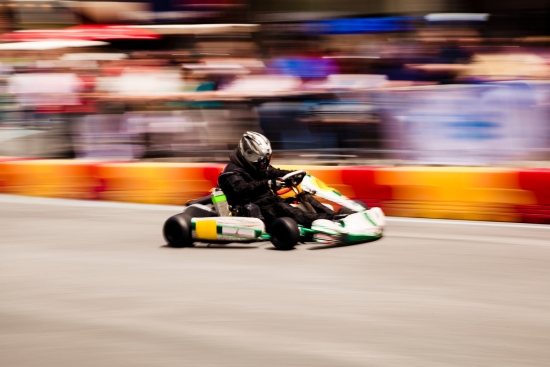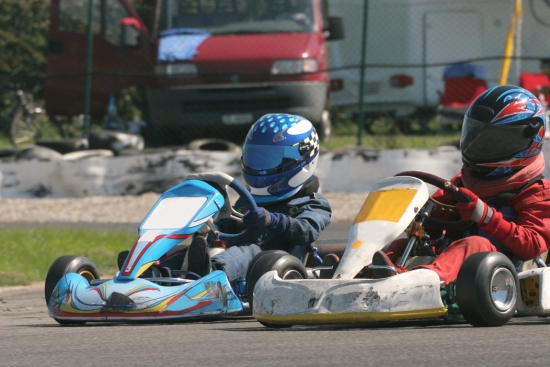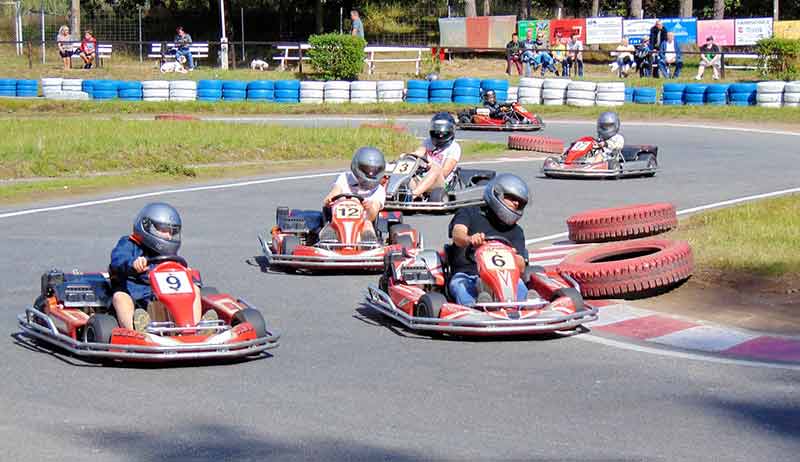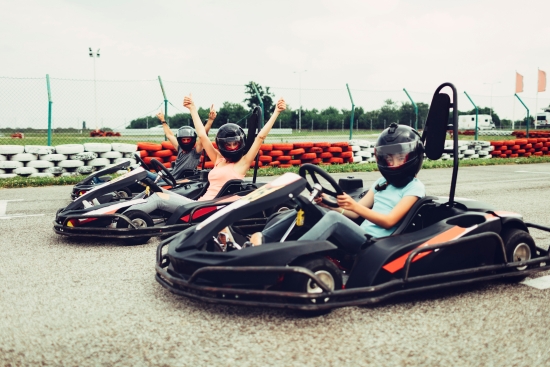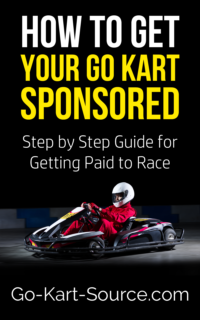In general, the fastest racing line is the straightest line basically. Now every corner has its own characteristic, its own optimal line based on whatever car or vehicle you’re driving.
But for the most part, you want to be going as straight as you possibly can for as long as you possibly can.
I mean I think that the fast way is just to join the dots. It’s like when you’re a kid you have those puzzles – you need to join the dots, that’s what you need to do to start.
A lot of people were there, and tried to drive too fast, too quickly. Missed turn-in points, missed apexes, untidy exits — Precision is the most important thing to start with when you’re a rookie. Once you can do that, then you can start to build speed.
But doesn’t matter if you’re starting, or if you’re a pro, you’ve got to get your apexes, you’ve got to get the lines correct.
Hitting The Apex
I mean the normal line will be coming from the outside to the apex and trek out again but sometimes there’s a little bit more ripple, more to the left foot inside, so then you just try to find the optimum out of it.
You have to be precise, you know — if the corner is laid out the way you have to, you know, hit the apex or go very close to the apex — you have to hit it. You hit your marks.
And it’s just the way you attack the corner, how you press the brake pedal — An engineer told me once that — and it’s so true — that the corner starts, as soon as you hit the brake pedal.
You’ll be going quick, quick in the middle, and get out quick. There can’t be a point in the corner, where you’re going to lose out.
To be, you know, quicker than the next guy, you’ve got to — every part of the corner has got to be better. You know some drivers have different styles, so they’re going to brake really late, get on throttle really early, and then in the middle, they might just lose a little bit of time.
Driving Style Evolves…
So if it’s kind of a little about of driving style. To me it’s about having my hands straight on steering wheel, when I’m doing a lot of my braking, and a lot of my accelerating.
So you’ll see my style has sort of evolved into a little bit more of a diamond of the corner, where I want to have as straight of hands as possible when I’m threshold braking, turn the car, and then have the car relatively straight to get the maximum traction off the corner.
It depends — what’s the straight like you’re braking from? What’s the length of that straight? What’s the length of the next straight? What are the bumps like? What are the surface changes?
You know, we have to deal with that a lot with the street courses, so they’re the fastest lane changes quite a lot depending on a lot of outside circumstances.
Because sometimes the grip level, or the highest grip is not only on the fastest line you could see on the paper, so you have to feel it in a way.
With Experience Comes Feel
With experience you, you really then pick this up very quickly, because you start to feel, okay there is a bit more grip there,
so even if it doesn’t look like the best line, you better drive there because you just carry more speed into the corners.
Sometimes the grip is just on the kerb, or maybe half a car width away from the kerb, or in the braking zones. Maybe it’s — you can’t be on the absolute ideal line in the brake because it’s bumby or something, and you got to move out of the way for those things.
So, it’s got to be — it’s part of how you pick the fastest line, it’s not absolutely the fastest line. When you look at a corner, you often need to process what is after that corner.
If there’s a half a mile straight away, you really need to emphasize the slow in quick out, versus maximizing your braking, and maybe compromising your exit.
Not All Corners are Equal
So there are some corners have more importance than others. Any corner that leads onto a long straightaway, is going to be more important than a corner that maybe leads to two or three more corners. So, in general the corners that have long straightaways, are places where you are on full throttle for a long time. Those are the corners that you want to really emphasize getting back to power sooner, and as, you know, as soon as you possibly can, and committing to the full throttle.
Yeah absolutely, and sometimes it means braking a little bit earlier to make sure you hit the apex and maybe not run so wide on that on the exit to be able to make sure you’re faster the next sequence of turns.
So, you always gotta think two, three steps ahead of where you are to be — to get the right line generally. There will be an emphasis on some corners to be fast in, and there will be an emphasis on some corners to be fast out of — two good examples that are connected to each other.
Coming out of the keyhole at Mid-Ohio, I want to be fast out of the keyhole.
At the end of the straightaway at Mid-Ohio turn 7, all I want to do is bring mega speed in. At the keyhole, I’ve got a really long straightaway, and a passing opportunity at turn 7 is no real passing opportunity, and the next corner that’s set-up is a really tight, tight, tight left-hand corner, so I can bring all the speed I can through 7 — not worry about the exit, not worry about when I get the power not worrying about getting over, back over to the right side of the track just bring speed through there, and the time that I make up on the entry to 7, is going to be more than if I back it off, set it up, and get a good entry to 8.
But the keyhole, conversely, is just the opposite. You got to back it off in the middle of that corner and get a big squared off, and get a big run outta there.
Fast out is most important for long straightaways.
Fast in would be important for a place where the road conditions and corner that follows it, is not as important. Maybe a big brake zone — things like that.
So you can — you have to pick and choose where you squeeze tenths of a second out of the lap. Set your marks up, get your brakes good, get the platform right as you come into the corner, and when it’s time to pull the trigger, hold onto the reigns — get that thing out of the corner.
Or if have — like here you have a long straight after hairpin, you get that hairpin wrong, you losing — you can watch on the dashboard these days you can watch the predictive time bleed away.
If you get a good exit, you can just see yourself gaining time the whole way. I mean, the really cool thing about modern-day cars is you’ve got a live delta time, in comparison to either, whoever set the fastest time in the car — be it yourself, or your teammates.
And you can see live, if you’re going faster or slower, at any time, any point in the track. He’s got a plus or a minus, and you always like to keep it on the minus — you going quicker.
But yeah, it’s very fascinating to see, if you change your line, or your braking point, you can see against the reference immediately what effect that has. And that gives us live information on what to do. So it’s like it’s your very own personal coach sitting there with you in the car.
Using the Kerbs
Obviously, when you take a kerb, you go a bit straighter into the corner, so the line is a bit better. But sometimes it upsets the car, so you have to feel what you can really do behind the wheel.
It’s never really easy to do, but then if it upsets the car too much, just stay off it a little bit. When you’re using kerb, you’re pretty much trying to open up the track as wide as possible and just utilize all that extra space you have.
Sometimes the kerbs are just rough — you know they’re really jagged edges, and you have an astroturf next to it, so if you get it a little bit wrong, it can really kill you for speed. And sometimes a kerb’s a nice round one, which you can take. But obviously, the flatter the kerb, the better really. And it changes from circuit to circuit.
If you can stay off the kerbs that’s for sure is best — cause then the car’s flat, and you can use the underwing of the car, and use the area a lot better. But if you got to use the kerbs, you got to use the kerbs.
Importance of Practice and Experience
Regular practice is the backbone of mastering advanced driving techniques. Think of it as a training ground for your reflexes and decision-making skills. Each time you take the steering wheel, you’re not just moving from point A to B; you’re actively sharpening your driving skills. This is particularly essential for racing drivers, where precision and quick reflexes are key.
Practicing isn’t just about repetition; it’s about ingraining habits and reactions into your muscle memory. In critical situations, such as navigating a busy highway or handling bad weather, these practiced responses can be lifesaving. They help you maintain control and make informed decisions swiftly.
Enrolling in advanced driving courses is a great way to practice in a safe and structured setting. These courses provide a controlled environment to experiment and learn from errors without real-world consequences. They cover a range of skills from defensive driving to high performance driving, preparing you for various driving scenarios.
Gaining Wisdom from On-Road Experiences
While practice lays the groundwork, real-world experience is the ultimate teacher in driving. Experience is about applying your learned skills in practical situations. It involves understanding the road ahead, being aware of potential hazards, and knowing the right course of action.
Skills like changing lanes require not just knowledge of traffic laws but also an intuition about the behavior of other drivers and vehicles.
Experienced drivers often develop an intuitive sense of driving. They know when to slow down even in the absence of road signs or speed limits. They’re adept at maintaining a safe following distance, using turn signals appropriately, and constantly checking their blind spot. This level of intuition comes from years of attentive driving and learning from every journey.
Moreover, seasoned drivers are generally better drivers because they’ve learned to adapt their driving techniques to varying road conditions. They understand the importance of steady speed and maintaining control in different driving scenarios, whether it’s a straight line or a winding road.
They know the importance of regular tire pressure checks, seat belt usage, and effective steering wheel handling.
In summary, both practice and experience form the pillars of being a safe driver. They empower you to confidently and skillfully manage your own vehicle, enhancing safety for everyone on the road.
Whether you’re a teen driver just starting out or an experienced motorist, there’s always more to learn and room for improvement. Every driving session is an opportunity to grow into a safer, more proficient driver.
Resources for Go Karting
There are some great books for learning the best techniques to get faster lap times by fine tuning your way around the track. While these are not all Karting Books (ie. Speed Secrets) there is a wealth of knowledge on how to become a better racer.

